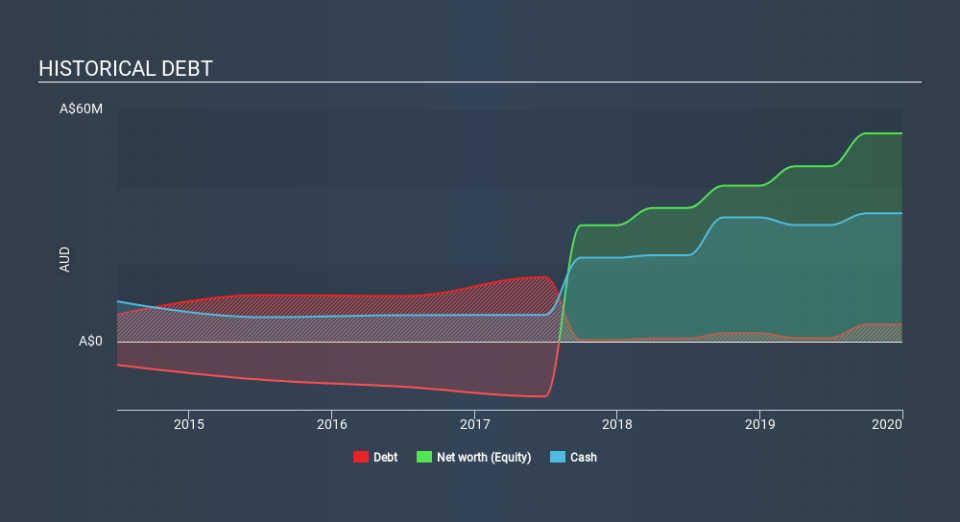Does Johns Lyng Group (ASX:JLG) Have A Healthy Balance Sheet?

Legendary fund manager Li Lu (who Charlie Munger backed) once said, 'The biggest investment risk is not the volatility of prices, but whether you will suffer a permanent loss of capital. It's only natural to consider a company's balance sheet when you examine how risky it is, since debt is often involved when a business collapses. We note that Johns Lyng Group Limited (ASX:JLG) does have debt on its balance sheet. But the more important question is: how much risk is that debt creating?
What Risk Does Debt Bring?
Generally speaking, debt only becomes a real problem when a company can't easily pay it off, either by raising capital or with its own cash flow. In the worst case scenario, a company can go bankrupt if it cannot pay its creditors. However, a more usual (but still expensive) situation is where a company must dilute shareholders at a cheap share price simply to get debt under control. Having said that, the most common situation is where a company manages its debt reasonably well - and to its own advantage. When we examine debt levels, we first consider both cash and debt levels, together.
View our latest analysis for Johns Lyng Group
What Is Johns Lyng Group's Debt?
As you can see below, at the end of December 2019, Johns Lyng Group had AU$4.29m of debt, up from AU$2.06m a year ago. Click the image for more detail. But it also has AU$33.1m in cash to offset that, meaning it has AU$28.9m net cash.
How Strong Is Johns Lyng Group's Balance Sheet?
The latest balance sheet data shows that Johns Lyng Group had liabilities of AU$85.1m due within a year, and liabilities of AU$33.1m falling due after that. On the other hand, it had cash of AU$33.1m and AU$73.9m worth of receivables due within a year. So its liabilities outweigh the sum of its cash and (near-term) receivables by AU$11.1m.
Since publicly traded Johns Lyng Group shares are worth a total of AU$538.2m, it seems unlikely that this level of liabilities would be a major threat. Having said that, it's clear that we should continue to monitor its balance sheet, lest it change for the worse. Despite its noteworthy liabilities, Johns Lyng Group boasts net cash, so it's fair to say it does not have a heavy debt load!
In addition to that, we're happy to report that Johns Lyng Group has boosted its EBIT by 55%, thus reducing the spectre of future debt repayments. The balance sheet is clearly the area to focus on when you are analysing debt. But it is future earnings, more than anything, that will determine Johns Lyng Group's ability to maintain a healthy balance sheet going forward. So if you want to see what the professionals think, you might find this free report on analyst profit forecasts to be interesting.
Finally, a company can only pay off debt with cold hard cash, not accounting profits. Johns Lyng Group may have net cash on the balance sheet, but it is still interesting to look at how well the business converts its earnings before interest and tax (EBIT) to free cash flow, because that will influence both its need for, and its capacity to manage debt. Over the most recent three years, Johns Lyng Group recorded free cash flow worth 72% of its EBIT, which is around normal, given free cash flow excludes interest and tax. This cold hard cash means it can reduce its debt when it wants to.
Summing up
While it is always sensible to look at a company's total liabilities, it is very reassuring that Johns Lyng Group has AU$28.9m in net cash. And it impressed us with its EBIT growth of 55% over the last year. So is Johns Lyng Group's debt a risk? It doesn't seem so to us. There's no doubt that we learn most about debt from the balance sheet. However, not all investment risk resides within the balance sheet - far from it. Consider for instance, the ever-present spectre of investment risk. We've identified 1 warning sign with Johns Lyng Group , and understanding them should be part of your investment process.
When all is said and done, sometimes its easier to focus on companies that don't even need debt. Readers can access a list of growth stocks with zero net debt 100% free, right now.
Love or hate this article? Concerned about the content? Get in touch with us directly. Alternatively, email editorial-team@simplywallst.com.
This article by Simply Wall St is general in nature. It does not constitute a recommendation to buy or sell any stock, and does not take account of your objectives, or your financial situation. We aim to bring you long-term focused analysis driven by fundamental data. Note that our analysis may not factor in the latest price-sensitive company announcements or qualitative material. Simply Wall St has no position in any stocks mentioned. Thank you for reading.


